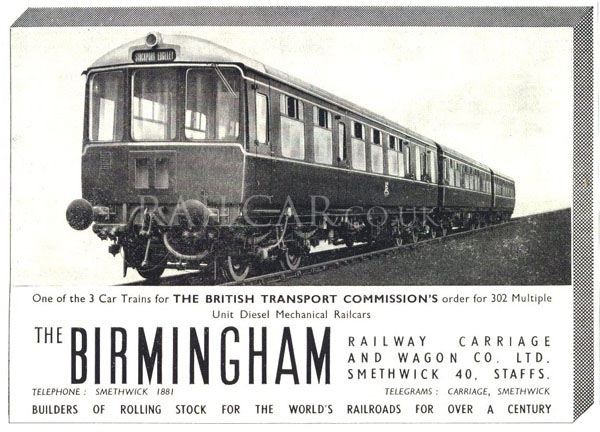Class 104 BRC&W 2, 3 & 4-car DMUs
Ordering Details
The vehicles originated from a decision by the British Transport Commission to push ahead with the introduction of DMUs with an announcement at the end of 1954 that it had authorised 1,408 new DMU vehicles to be built. Prior to then only 232 vehicles had been authorised, all for carefully planned out schemes (distinct operating areas).
It was a bold step, the £17,570,000 investment for 858 power cars and 550 trailers for "likely requirements for the immediate future" was at a time when only eight sets had entered traffic (in the West Riding). It was recognised that British Railways own workshops could not cope with building this volume of vehicles, and it was anticipated that contractors would build 910 of them, Derby the remaining 498.
All the 302 vehicles were ordered at once, the BRC&W works numbers were 9712 to 9716 for the DMBS, DMC, DTC, TS/TC and TBS respectively.
Originally 393 vehicles were ordered, 91 vehicles (81 for the NER and 10 for the LMR) would be cancelled and built at Derby Works in light alloy instead (as Class 108s), presumably to speed up deliveries due to the steel shortage at the time.

London Midland Region Plans
The minutes of the London Midland Region Diesel Trains Committee gives us an insight into how the Region planned to utilise the vehicles it would receive from the bulk order. The first relevant mention is in the 8th February 1955 meeting, where it requests 168 power cars and 116 trailers for the Manchester (London Rd.) area scheme. It also requested 17 power cars and 13 trailers for the Birmingham - Lichfield line, for which Lightweight vehicles scheduled to be built at Derby were initially allocated.
The earliest breakdown of the 1,408 vehicles per builder I've found is dated 31/3/55 in the minutes of the April 19th 1955 meeting. The BRC&W were to build 393 vehicles, consisting of 36 2-car sets, 56 3-car sets, 21 4-car sets, 5 6-car sets, and 39 spare vehicles. The meeting also mentioned that the "B.T.C. are considering allocation and delivery schedules, including modifications in respect of the four 3-car sets for the Birmingham, Sutton Coldfield, Lichfield scheme."
At the next meeting on June 21st an appendix details the allocations of the different builds to different schemes. The Birmingham Part 1 (Birmingham - Lichfield) scheme was now allocated nine two-car Derby Lightweights and four three-car BRC&W sets. Fifty-two BRC&W three-car sets were allocated to the Manchester Part 1 scheme. This split in the three-car sets between two different schemes, despite being the same order, is probably the reason behind why the vehicle and lot numbers of the first four sets are split from the following fifty-two sets. The Manchester scheme was also allocated sixty-four two-car power-trailer sets, fifteen from BRC&W, the others from Derby, GRC&W, and BUT (Park Royal).
The scheduled delivery dates at this time (June 1955) were:
March 1956 - 4 3-car sets for Birmingham Part 1
April 1956 to February 1957 - 52 3-car sets for Manchester Part 1
February to March 1957 15 2-car sets for Manchester Part 1
At the same June meeting it was pointed out that the BRC&W units for the Birmingham - Lichfield line were not scheduled for delivery until March 1956, yet it was hoped to introduce diesels to the line in the New Year (1956). The committee agreed on the loan of eight Derby built-two car sets from the Manchester scheme which were expected to be delivered before the end of the year to cover until the three-car BRC&W sets were available.
There was no mention of the units of note in the following meeting but at the next (October 4th, 1955) the allocation to schemes saw a switch of five of the power-trailer sets from Manchester Part 1 to the Birmingham Part 2 scheme. At the next meeting all fifteen power trailer sets were allocated to the Birmingham Part 2 scheme but it remained a ten - five split, ten sets due in Aug./Sep. 1957 and the remaining five more than a year later in Oct./Nov. 1958.
At the 42nd meeting in August 1956 it was noted that 91 vehicles had been cancelled from the BRC&W order, these 91 vehicles were now to be built at Derby. That reduced the BRC&W vehicle total from 393 (as mentioned in meeting 32) to 302 (the number of Class 104 vehicles actually built). The 91 vehicles included the five power trailer sets for the Birmingham Part 2 scheme, the remainder were from the North Eastern Region allocation.
At meeting 43 (30th October 1956) the four three-car sets allocated to Birmingham Part 1 were moved to the Derby, Nottingham and Leicester scheme, the following meeting two of those were now allocated to the Birmingham Part 2 scheme. After that there were no more published changes. The scheduled delivery order to LMR schemes on 27/12/56 was as follows:
March - December 1957 - 52 3-car sets to Manchester Part 1
January 1958 - 2 3-car sets to Birmingham Part 2 and 2 3-car sets to Derby,
Nottingham & Leicester
February/March 1958 - 10 2-car sets to Birmingham Part 2
Summary
Ordering Details
Description
Interiors
Modifications
Single Engine Conversion
2-car diagrams & Works Pics
3-car diagrams & Works Pics
4-car diagrams & Works Pics
Numbering & Drivers Instructions
Liveries
Operations - Early Days
Operations - Later Days
Operations - Scotland
Accidents
Decline
Non-Passenger Use
Images
Details about preserved Class 104s can be found here.
Many thanks to Kevin Dowd for his assistance in the preparation of these pages, and to Eddie Knorn for further data.


